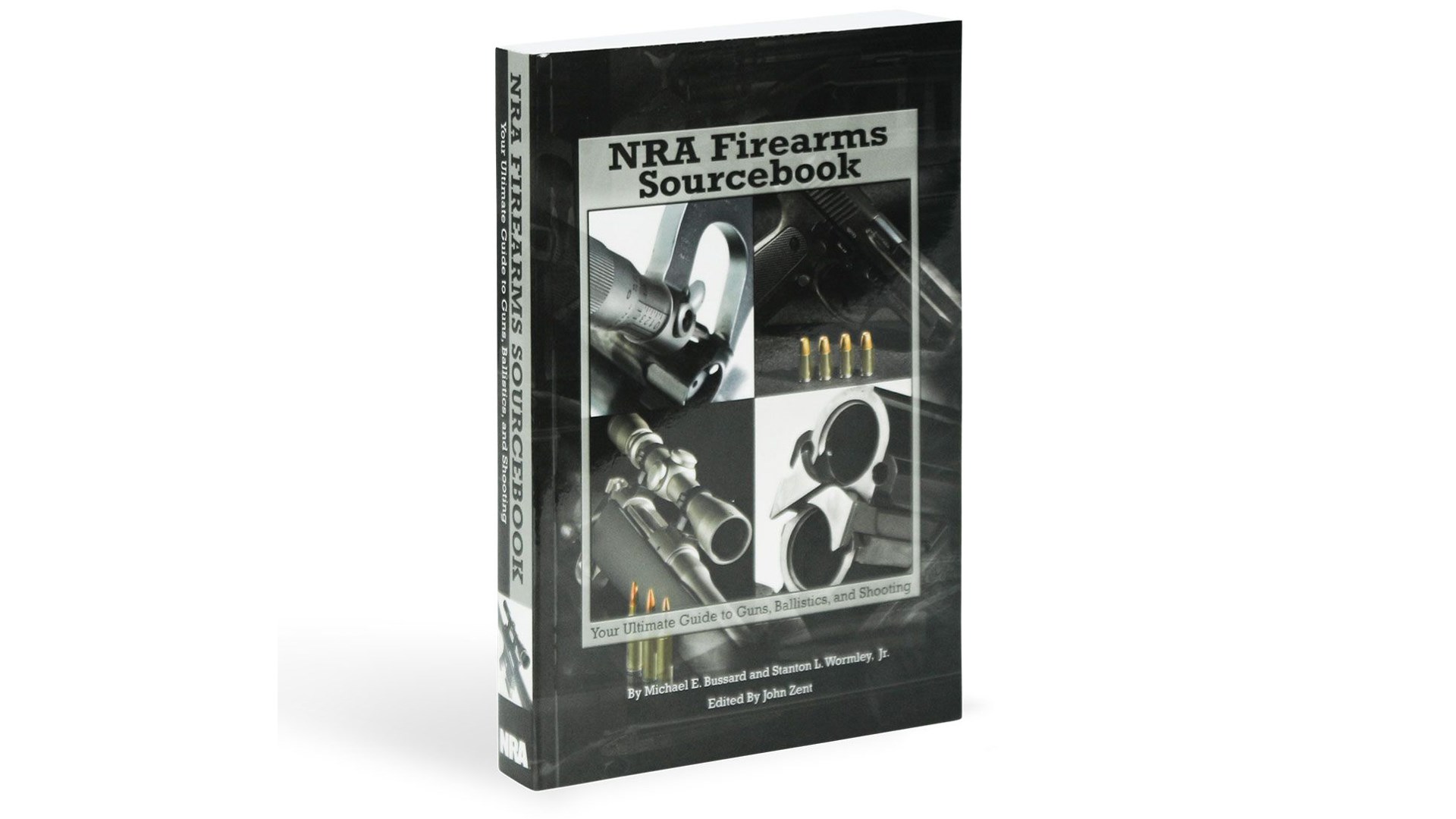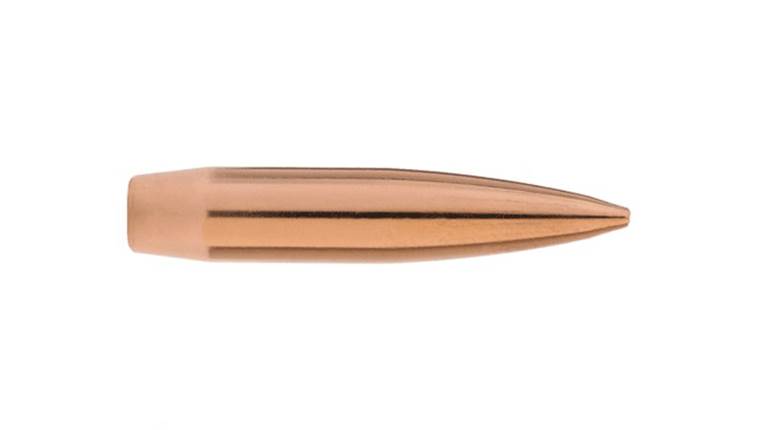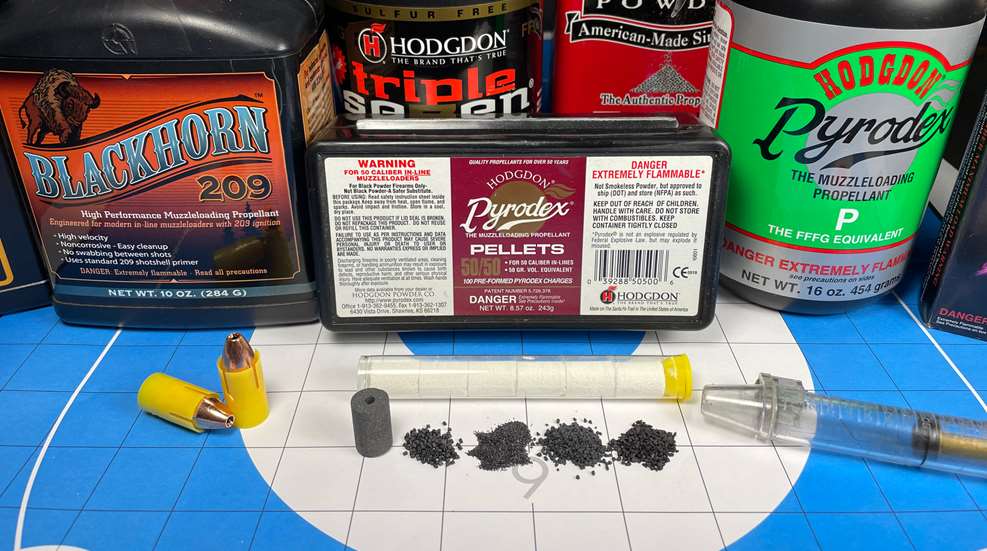
The odds that the rutting buck boasting oversized antlers would show in the same field—little larger than an acre or so—for a third consecutive sitting seemed small. After all, mature whitetails don’t become such by throwing caution into the wind—except during the rut. Nonetheless, I hoped. I had also switched setups, eliminating the vast quantities of flora that had foiled my attempts to the harvest the deer on the previous two brief encounters. Doing so also shortened the shot distance. Considering I was toting a muzzleloader, the latter was a real consideration.
Movement straight ahead, at the edge of the field, interrupted what had been an uneventful three-hour sit. Initially thinking it was a large doe emerging from the thicket coming to graze, the massive, thick antlers and stately physique of an aged buck quickly changed that perception. It was him, and he was walking directly toward me.
With the long-barreled, .50-cal. Knight LK-93 pre-nestled on shooting sticks, I quickly prepared for a shot the moment he turned broadside. It didn’t take long, as he veered left (my right) to exit the field in an unending search for more feminine companions. As the window to take a shot was quickly shutting, the muzzleloader heaved, sending the Barnes 245-grain Spitfire projectile speeding downrange. The lingering, wafting smoke thinned enough to reveal a lethal hit, and seconds later (and about 40 yards distant), the buck succumbed.
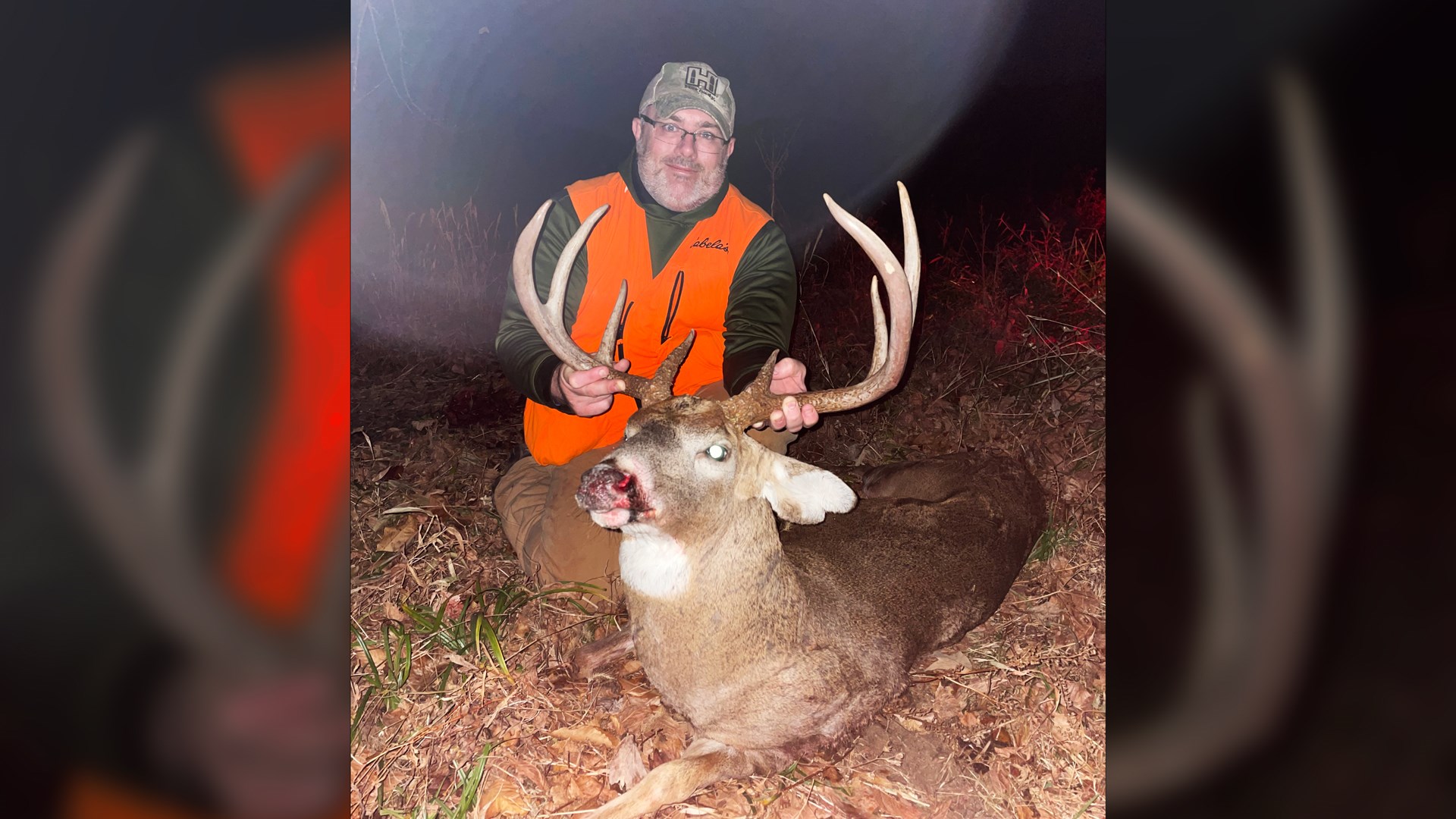
The Virginia whitetail mentioned above, which was taken during the 2023-24 season, was among my largest to-date, and but one of many through the years that filled the freezer during the two-week season that generally aligns with the rut. But this article isn’t about hunting; rather, it focuses on a necessary, yet misunderstood, component used to collect game or punch paper when using a muzzleloader—powder.
Consider it a curse or blessing, today’s muzzleloader shooters and hunters have available to them a plethora of projectile-propelling options, ranging from the antiquated blackpowder to the newfangled Federal Premium FireStick; however, although there is overlap in places, powders are unique in their advantages/drawbacks, ignition and platform requirements, and performance. This article is to serve as a primer, not an all-encompassing review, of muzzleloader powders.
Blackpowder
When my revered LK-93 billowed smoke on the evening of Veteran’s Day 2023, it wasn’t generated by the latest reincarnation of our oldest powder; rather, it was the real deal. In fact, the 80 grains/volume charge was Olde Eynsford 2F Royal Blend blackpowder, which was manufactured by GOEX in Minden, La. There was more than nostalgia at play. But, first let’s detail its composition.
According to the NRA Firearms Sourcebook, “Blackpowder [is] the oldest propellant used in firearms [and is] generally composed of a mixture of potassium nitrate [saltpeter], carbon, and sulfur.” Further, the manual reports the following proportions, “charcoal—15½ percent; sulfur—10½ percent; and potassium nitrate—74 percent.” Sources disagree of the exact definition, but it’s nonetheless accepted as a sensitive, or volatile, explosive.
It’s the consistency of the granules, as well as range of sizes (from 1F to 4F, with the latter being the finest), and sensitivity—read as easily ignited—that endears it to many muzzleloader enthusiasts—especially those who use percussion sidelocks and flintlocks. A smidge of 4F blackpowder is the most popular choice for the priming pan of the latter, which is used to ignite the primary charge. Depending on the caliber, 2F or 3F will usually be used for the main charge, which is seated behind the projectile (or wad/overpowder card(s) with shot in a muzzleloading shotgun). Few replacements exist for these applications, and none satisfactorily replace authentic blackpowder. But, it shouldn’t be limited to replicas of firearms from yesteryear.
Blackpowder has several drawbacks, which I’ll cover momentarily; however, these shouldn’t overshadow its advantages. First, blackpowder is relatively inexpensive. A quick survey of Grafs revealed that the house brand is about $25 per pound, and Swiss Black Powder—arguably the best—is $40 for the same quantity. What’s more, I’ve found that, through testing on my own muzzleloaders and those for articles, blackpowder will generally provide better consistency and thus accuracy. That’s why it’s often my powder of choice. Moreover, I’ve never had a delayed ignition, and I’ve killed deer beyond 225 yards with the abovementioned combination, so why change.
But, there are tradeoffs, and blackpowder has many. First, blackpowder is dirty—extremely filthy. In fact, without swabbing the barrel between shots (with saboted bullets), expect subsequent loading to get much tougher. That being said, it’s easily cleaned using a water-based solution; some people used water with dish soap. Cleaning must be initiated shortly after firing, as blackpowder is corrosive and will rapidly rust and/or pit the steel barrel. The breechplug (if present) can become exceeding difficult to remove, too.
Thanks to the powder’s sulfur content, the smell is appalling. It won’t bother you while hunting or at the range, but it’s an unwelcome guest in the home. Trust me. Expect glances from your family upon your return. This can somewhat be alleviated, not eliminated, by swabbing the barrel before leaving the range or field.
Blackpowder is also hygroscopic, and thus readily wicks moisture, rendering it unreliable. Under most circumstances, this is a non-issue; however, if you dump a charge into a cleaned barrel without drying it (swabbing and/or firing a cap or two), you risk ruining the powder and getting a delayed fire or none at all. Exposure to moisture via the pan, nipple, breechplug and muzzle should be prevented, too. Personally, I haven’t faced this, as I’m diligent about the loading process and protecting the powder while afield.
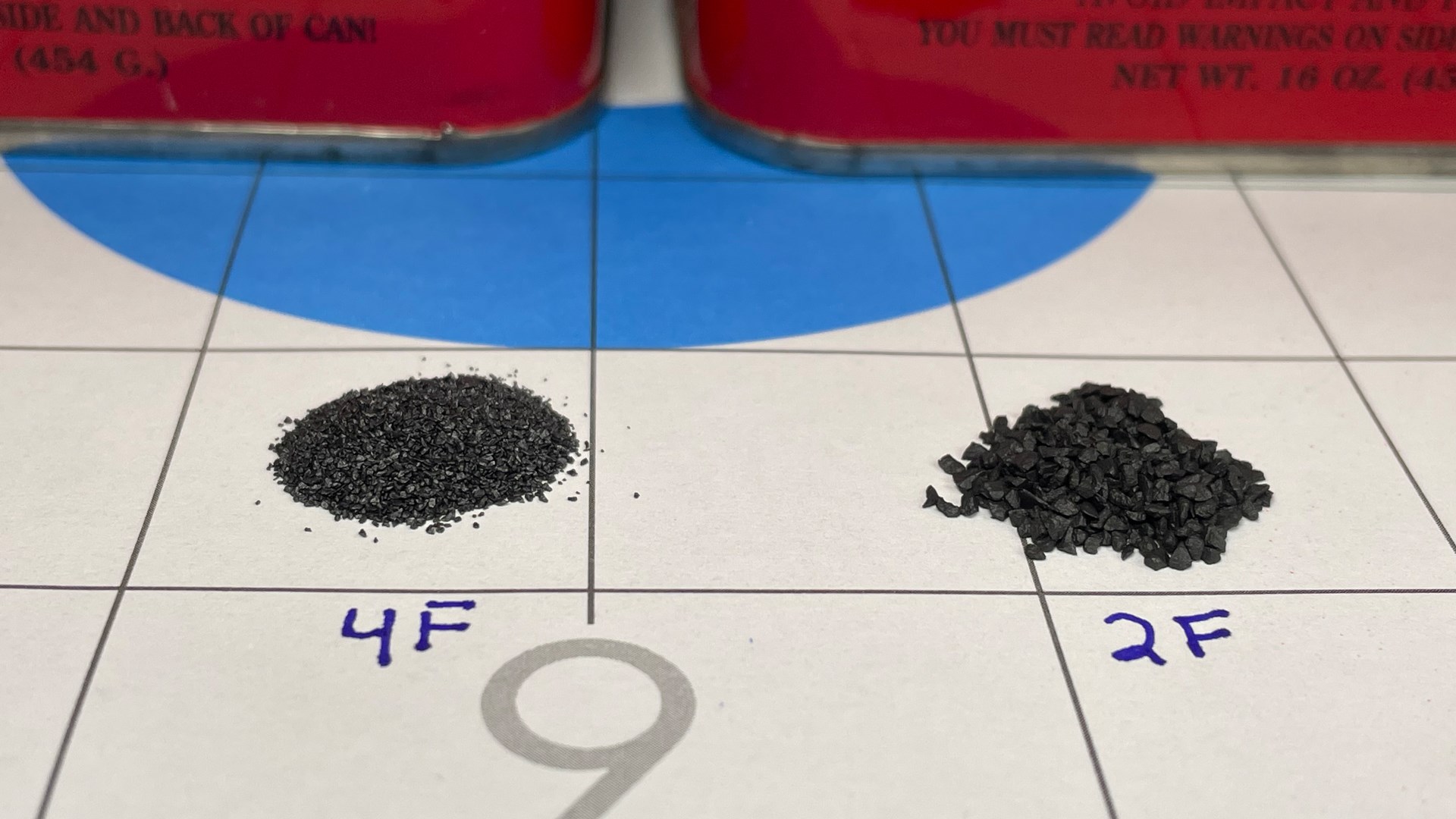
Know up front that blackpowder doesn’t have the same energy content as do its substitutes. In short, equivalent charges of blackpowder and a safe replacement, such as Hodgdon Pyrodex, won’t have comparable velocities. Blackpowder always falls short. For instance, according to Barnes Bullets, whereas 90 grains/volume of GOEX 2F blackpowder propels a 245-grain Spitfire bullet to 1,467 f.p.s., the same charge of Pyrodex attains 1,759 f.p.s., and Hodgdon 777 hits 1,944 f.p.s. Those are noteworthy differences, but unless shooting at extended ranges or on larger species, the velocities you get with blackpowder will produce acceptable energy and trajectory.
Additionally, it’s also important to note that, whereas smokeless powders are generally measured by weight in grains, blackpowder is measured by volume (grains/volume). For a given granulation and brand of powder, one can determine the weight of a thrown volume of powder to chase consistency. But when folks speak about “grains of blackpowder,” they’re gauging how much space it takes up in a measurable container, not how much it weighs on your reloading scale.
Lastly, as blackpowder is especially sensitive, great care must be taken with storage and transport. The former is why many gun stores and sellers of muzzleloaders, particularly big box stores, don’t carry it. You might even find that you must purchase it from an online retailer and have it shipped direct. But, for all its shortcomings, don’t discount blackpowder for what counts most—accuracy. And that why I still like it.
Blackpowder Substitutes
Blackpowder substitutes are those propellants—yes, adequately described as propellants—that can safely be used to replace authentic blackpowder in muzzleloading firearms. The original replacement, Hodgdon Pyrodex, was patented and first distributed in 1976, and is still available. Frankly, it’s still among the best options, particularly for sidelocks and flintlocks, though it has lost market share to recent inventions.
Similar in size to 2F blackpowder, Pyrodex RS can be used on an equivalent basis, but as previously mentioned, provides an appreciable boost in velocity for flatter trajectories and less wind deflection. Hodgdon also manufactures Pyrodex Select, which has a more consistent granule size for precise measurement and improved accuracy, as well as Pyrodex P, a 3F equivalent.
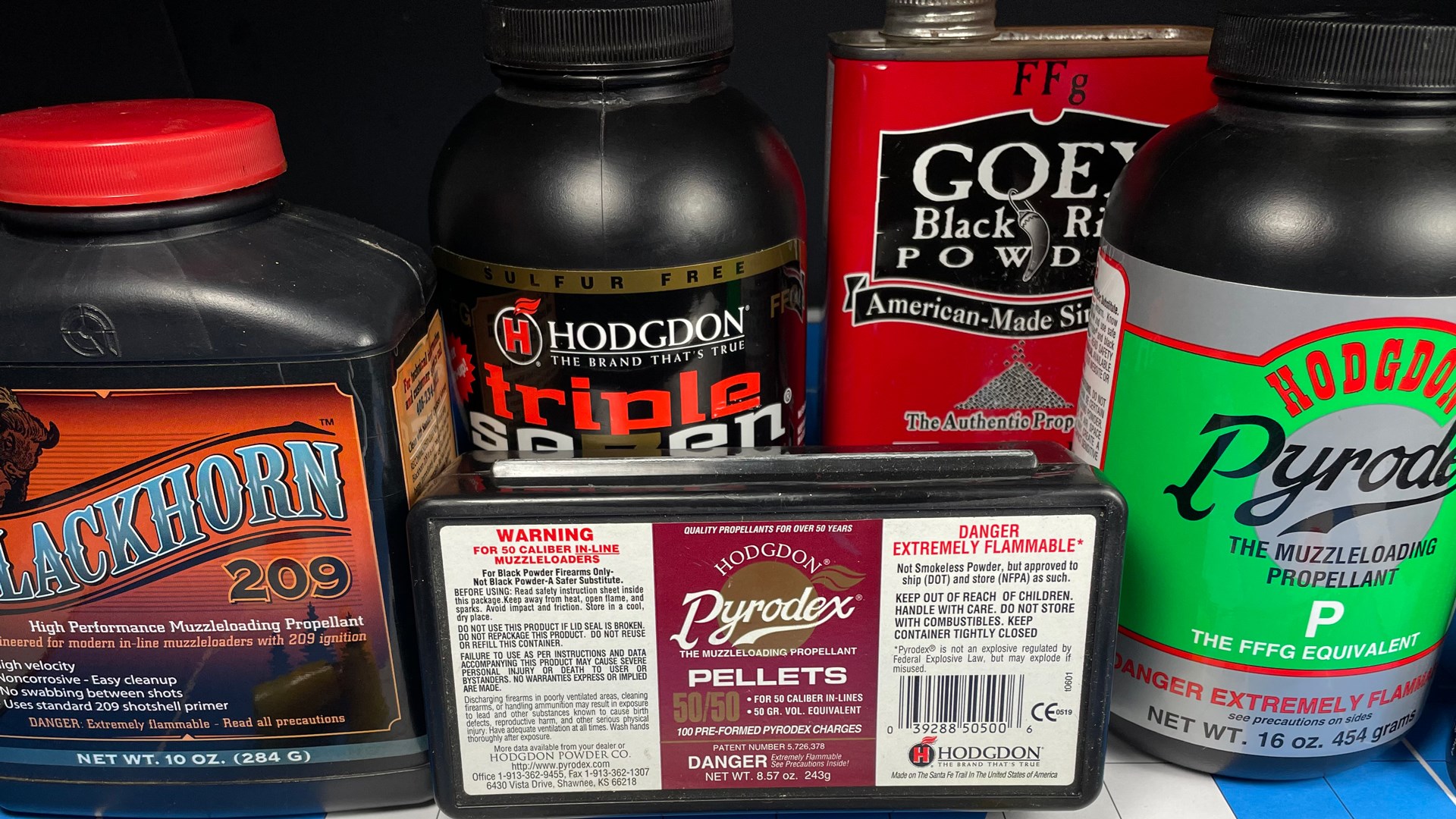
Although unclean (but far lesser so than blackpowder), Pyrodex cleans up easily with a water-based solution and has a less insufferable smell, though it’s still rightly present. Swabbing the barrel before leaving the field or range, or cleaning in an isolated place, is recommended. As with blackpowder, post-firing, the cleaning process shouldn’t be delayed due to corrosion, and swabbing between shots eases the loading process. For retailers and consumers alike, Pyrodex is less volatile and thus safer to handle and store, which is why nontraditional vendors carry it and not blackpowder. It’s priced comparatively to blackpowder, though Select is a tad more expensive.
Simply stated, if you’re adverse getting your hands dirty or abhor rank smells, Pyrodex is not for you. But, if you want an inexpensive, safer alternative to blackpowder that provides good velocities and excellent accuracy, too, it’s a good option. A second muzzleloader of mine, an early Knight MK-85 .50 caliber, shoots best with a PowerBelt 245-grain, hollow-point bullet atop of 100 grains/volume of Pyrodex RS.
While Pyrodex was a substantial improvement over blackpowder, the chief complaints of blackpowder—dirtiness and odor—weren’t fully addressed. That was the intent behind developing Hodgdon 777 (Triple Seven) 2F, which debuted in 2001. Since 777 lacks sulfur, so too is the non-existence of the “rotten egg” smell that accompanies the chemical element. What’s more, 777 cleans up easily with water (or water-based solution), and though cleaning isn’t required immediately, forgetting to do so will result in corrosion to your muzzleloader; it’s not a smokeless propellant.
Additionally, it offers additional velocity, to boot. Reflecting on the earlier numbers, a 90-grain/volume charge of 777 is 477 f.p.s. and 185 f.p.s. faster than the same charge of blackpowder and Pyrodex RS, respectively. My Knight) yes, another Knight) .52-cal. Bighorn uses a 275-grain Bloodline atop of a 120-grain/volume charge of Triple Seven.
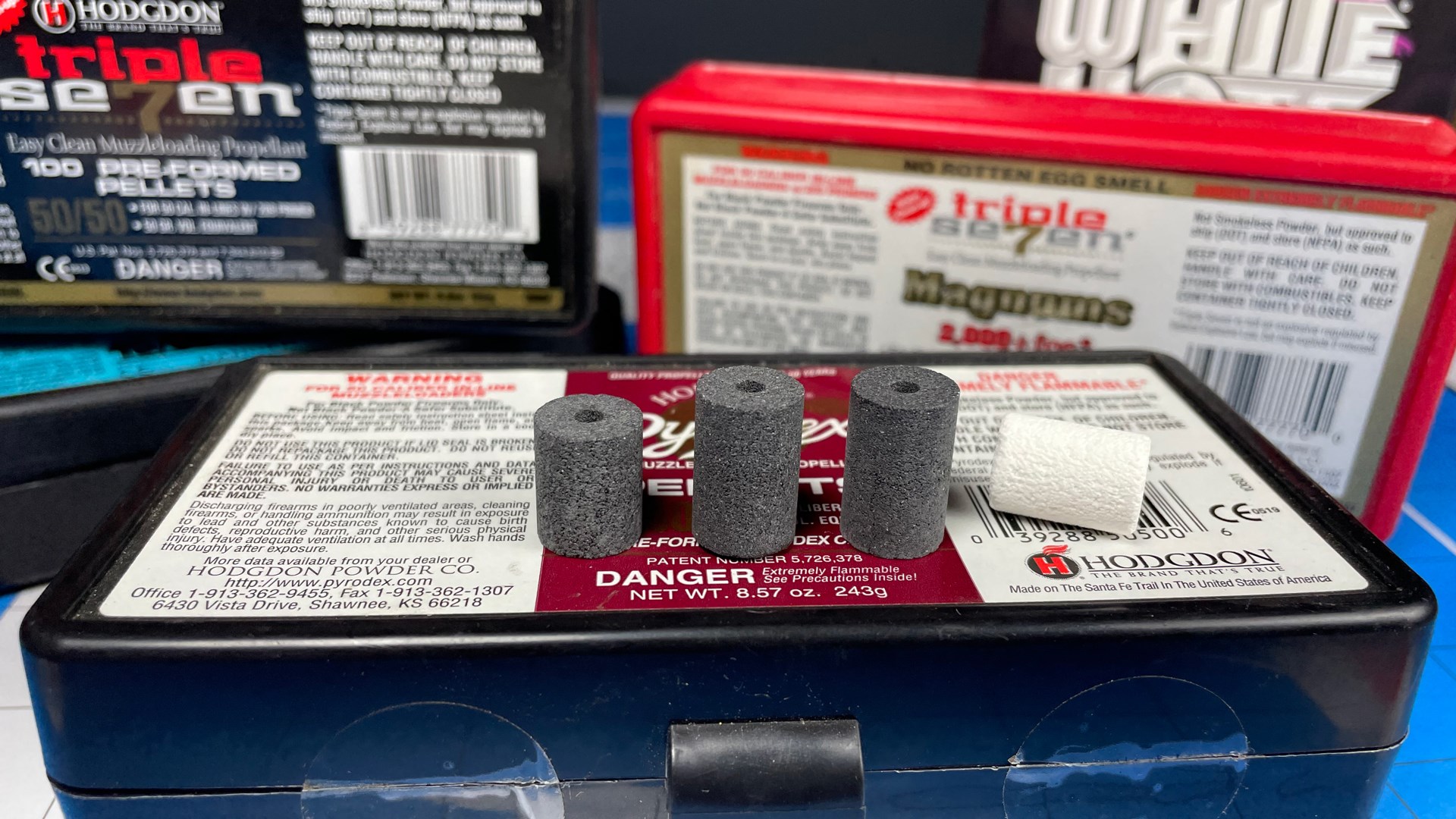
Both Pyrodex and Triple Seven can be had in loose (granule) form or pelletized into cylinders, with the former debuting in 1996. The obvious difference—form—is immediate, but it can skew the decision-making process. The primary benefit of pelletized propellant is ease of loading, but is only really beneficial in stressful, time-constrained situations, such follow-up shots while hunting. The compromise is that pellets are limiting in charge weights, and they’re more costly.
For instance, in Pyrodex only 50-cal., 50-grain/volume pellets can be had, so you’re limited to two- (100-grain) or three- (150-grain) pellet loads. If your muzzleloader doesn’t jibe with them, you’re out of luck. There are also .44/.45-cal., 30-grain/volume pellets. Triple Seven has a bit more versatility, offering .50-cal., 30-, 50-, and, in Magnum variant, 60-grain/volume charges. This provides options for tailoring loads. There is also a .45-cal., 50-grain/volume pellet. One must consider ignition source before selecting. Triple Seven pellets require a 209 shotshell primer, while Pyrodex can be ignited by No. 11 percussion cap and musket caps. Why? The latter has a small quantity of blackpowder on the base to aid the process, but the attendant drawbacks of blackpowder are present, too.
Hodgdon Powder Co. also sells .50-cal., 50-grain/volume IMR White Hots. Similar to Triple Seven pellets, albeit white, the temperature-insensitive propellant offers elevated velocities with easy cleanup (just water), optional swabs between shots and no residual odor.
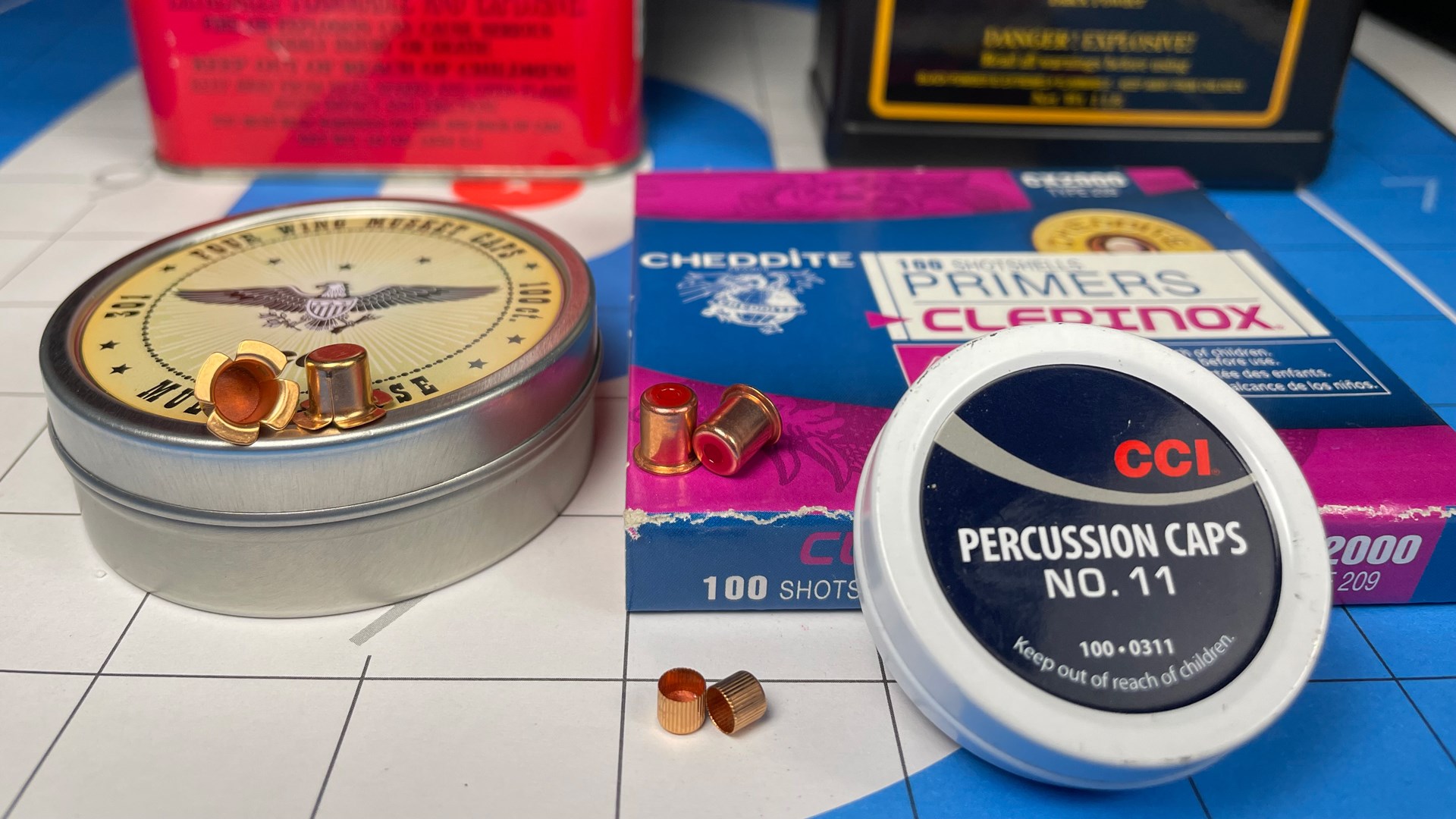
In general, preformed pellets won’t give you the best accuracy because you cannot work up loads. For instance, instead of two, .50-cal., 50-grain/volume pellets (100-grain/volume) charge, your muzzleloader might shoot best with 90- or 95-grain/volume charges. However, you won’t know if you’re sticking to pellets, and that’s why I don’t like them in most cases.
Other powders with attributes similar to Triple Seven include Shooter’s World Multi-Purpose Black, which is made in America by American Pioneer Powder, and Alliant Blue MZ. The former can be had in loose and pellet forms, while the latter is available in pre-formed charges only. In general, pellets cost more than their loose counterparts.
A more recent variant of pelletized propellants is Hodgdon’s FireStar. Instead of a basic cylindrical shape with a hole ventilating the center, FireStar pellets have a geometric star shape with longitudinal grooves on the outside in addition to the hole in the center. Why? Extra surface area is exposed for more consistent ignition. Unlike those pellets mentioned above, three FireStar pellets is equivalent to 100 grain/volume, which is the maximum charge. This cannot be surpassed. The company also reports a 50-f.p.s. increase in velocity and easy clean-up.
Perhaps the most admired and desired muzzleloader propellant is Canadian-made Blackhorn 209. This option is truly different than any others on this list. Visually more akin to extruded smokeless propellants than its muzzleloader siblings, non-hygroscopic, temperature-insensitive Blackhorn 209 is designed for use in modern inline muzzleloaders featuring an enclosed breechplug and 209 shotshell primer ignition. It cannot be used with flintlock, percussion-cap and musket-cap ignition systems.
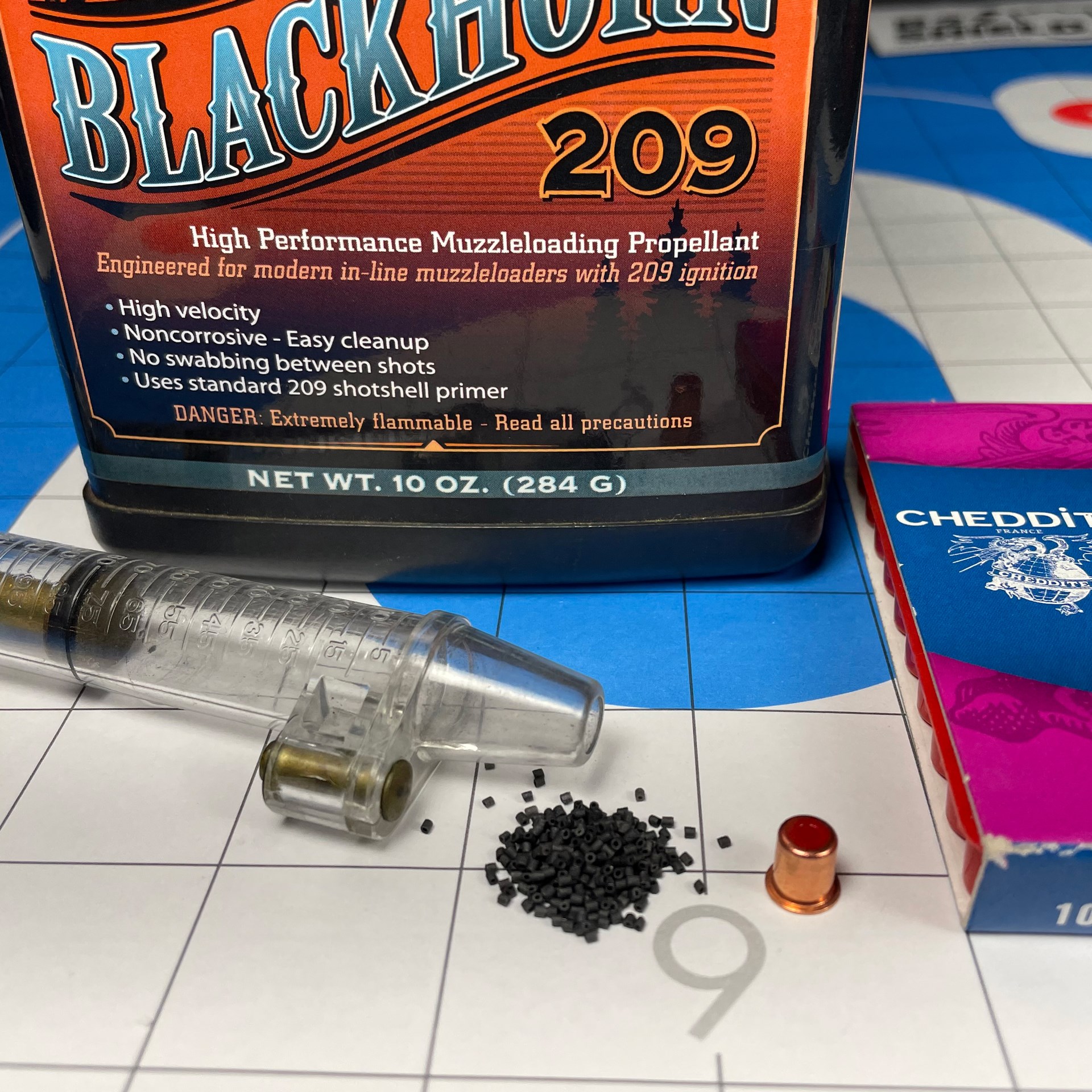
Blackhorn 209 burns extremely clean. Know up front that blackpowder doesn’t have the same energy content as do its substitutes. In short, equivalent charges of blackpowder and a safe replacement, such as Hodgdon Pyrodex, won’t have comparable velocities. Blackpowder always falls short. For instance, according to Barnes Bullets, whereas 90 grains/volume of GOEX 2F blackpowder propels a 245-grain Spitfire bullet to 1,467 f.p.s., the same charge of Pyrodex attains 1,759 f.p.s., and Hodgdon 777 hits 1,944 f.p.s.
Those are noteworthy differences, but unless shooting at extended ranges or on larger species, the velocities you get with blackpowder will produce acceptable energy and trajectory leaving minimal residue, and no objectionable smell; however, cleanup requires an oil-based solvent, not water, as you would on a centerfire rifle. Although not corrosive, cleaning after use is recommended. Swabbing between shots is unnecessary. It’s the carefree nature of Blackhorn 209, as well as superb accuracy and elevated velocities, that attracts admirers. Concerning speed, as an example, 100- and 120-grain/volume charges will push a .50-cal. Barnes 250-grain Expander to 1,923 and 2,121 f.p.s., respectively.
But the downsides of Blackhorn 209 are availability and cost. Stocks of it are made infrequently and sell quickly, and, at the time of this writing, was $89 per eight ounces—very pricey.
Something Different … Way Different
For centuries muzzleloaders have been, well, muzzleloaders, with the same slow, onerous loading process. That has changed with Federal Premium’s FireSticks, which have Hodgdon Triple Eight propellant contained within a plastic container, or cartridge, to which a 209 shotshell primer will be added. As such, it’s similar to a modern cartridge. The smoke pole is loaded by first ramming home the projectile via the muzzle, then adding the FireStick and primer via the breech. Should the gun not be fired, the FireStick is removed and the gun doesn’t have to be shot. What’s more, since the propellant is contained, it’s protected from moisture.
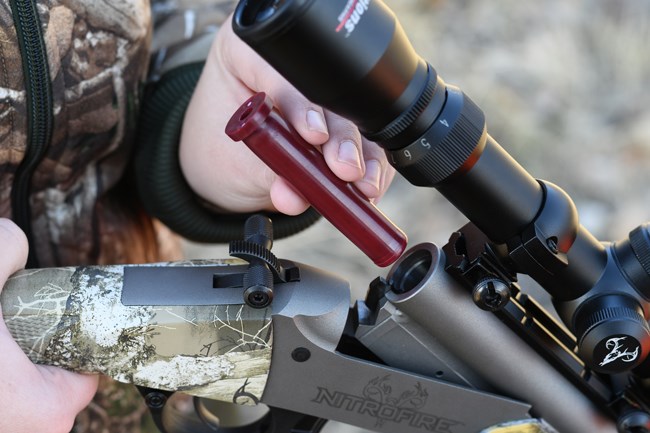
Now, for the drawbacks; since the charge is predetermined, there’s no way to experiment with charge weight or propellant type. Hopefully, what is offered will produce satisfactory accuracy in your gun. As you’ve probably surmised, FireSticks are pricey. They’re about $27 per 10, which is about the cost of premium, centerfire rifle ammo. Convenience is costly. In addition to the Traditions NitroFire, the first FireStick-capable muzzleloader, there is the CVA Crossfire. I’d expect more options to appear in time.
When it comes to muzzleloader propellants, there are a host of options from which to choose. Athough there is frequently crossover, none are suitable across the board—none. If you consider what was introduced in this article, though, you’ll make the right choice for you and your muzzleloader.
